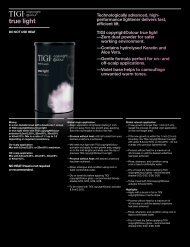For The Love Of Colour - TiGi
For The Love Of Colour - TiGi
For The Love Of Colour - TiGi
Create successful ePaper yourself
Turn your PDF publications into a flip-book with our unique Google optimized e-Paper software.
understanding<br />
level and tone<br />
<strong>Colour</strong> level is the lightness versus the darkness<br />
of a shade or tone. In order to become aware of<br />
which level each tone naturally falls into, compare<br />
each tone to the grey scale.<br />
—Violet is much deeper and darker than yellow.<br />
—<strong>The</strong> more violet used, the deeper the end result.<br />
— <strong>The</strong> less violet used, the lighter and brighter<br />
the end result.<br />
How to become conscious of the tone and level<br />
In order to become conscious of each level of tone,<br />
relate the colours to the equivalent grey.<br />
Example: looking at the tone graduation on the<br />
grey scale you can clearly see how different the<br />
yellow is versus the violet.<br />
In order to create a violet on the same level as<br />
the yellow, you would need to dilute the tone.<br />
If darker levels are used to intermix a colour,<br />
the result will come out deeper and muted.<br />
<strong>The</strong>refore, be aware of level overriding tone and<br />
tone overriding level. On darker levels more<br />
tone will be required; on lighter levels smaller<br />
amounts of tone will be needed.<br />
the law of colour<br />
the grey scale<br />
10<br />
9<br />
8<br />
7<br />
6<br />
5<br />
4<br />
3<br />
2<br />
1<br />
the global<br />
numbering<br />
system<br />
<strong>The</strong> global numbering system is for the hairdressing<br />
industry worldwide. It will guide hairdressers<br />
through the range of natural and artificial haircolours.<br />
<strong>The</strong> level of colour refers to how light or how dark<br />
the colour is and the tone describes the hue or<br />
essence of the colour.<br />
A numbering system helps to define our colour<br />
descriptions. 1/ to 10/ represents the level,<br />
/0 to /8 represents the tone or tones.<br />
Warm tones give the sense of richness and can<br />
be as vibrant or as soft as you desire. Warm tones<br />
consist of red, copper, copper red, copper gold,<br />
and gold.<br />
Cool tones such as light violet, steel blue, green/<br />
matte, and calibrated ash are used to soften and<br />
neutralise any unwanted warm tones in the hair.<br />
Mahogany and deep violet are used to<br />
emphasise the tone.<br />
Complementary tones<br />
A combination of complementary tones produces<br />
a shade which can be either warm or cool.<br />
Harmonious shades from light beige to dark<br />
brunette are created this way.<br />
Natural tone<br />
Denoted with a /0, the natural tone is actually<br />
neutral, neither warm nor cool.<br />
the law of colour<br />
NEUTRAL WARM TONES<br />
LEVEL COOL TONES<br />
⁄ 0<br />
⁄ 3<br />
⁄ 4<br />
⁄ 6<br />
EXTRA LIGHT BLONDE<br />
10 ⁄<br />
9 ⁄<br />
8 ⁄<br />
7 ⁄<br />
6 ⁄<br />
5 ⁄<br />
4 ⁄<br />
3 ⁄<br />
2 ⁄<br />
1 ⁄<br />
⁄ 2<br />
⁄ 5<br />
⁄ 7<br />
GREEN/<br />
MATTE<br />
⁄ 1<br />
⁄ 8




